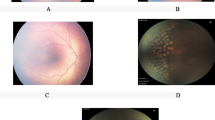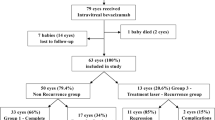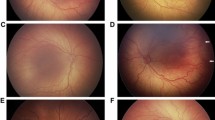Abstract
To study the anatomical success rate of light amplification by stimulated emission of radiation (LASERS) as first line of management in stage 4A retinopathy of prematurity (ROP). Observational, prospective case series of 14 eyes of 7 babies (males: 3, females: 4) with stage 4A ROP who underwent LASERS for stage 4A between January 2018 and July 2019. Gestation age (GA), birth weight (BW), and post-menstrual age (PMA) at which laser was done were noted in all cases. A number of clock hours of detachment at the time of presentation were noted in all babies. All babies were followed up up to 6 months after laser for any recurrence. Success was defined as complete regression of disease without the need of any other modality of treatment like anti-vascular endothelial growth factor (anti-VEGF) or pars plana vitrectomy. A total of 92.85% (13/14) showed complete regression of disease. One eye progressed to stage 4B ROP warranting lens-sparing vitrectomy (LSV). LASERS is an effective method of management without any need of anti-VEGF or surgical intervention even in babies with stage 4A ROP.






Similar content being viewed by others
Data availability
Not applicable
References
Sukgen etal EA (2017) Treatment for stage 4A retinopathy of prematurity: laser and/or ranibizumab. Graefes Arch Clin Exp Ophthalmol 255(2):263–269
International Committee for the Classification of Retinopathy of Prematurity (2005) The international classification of retinopathy of prematurity revisited. Arch Ophthalmol 123:991–999
Mueller B et al (2017) Treatment of type I ROP with intravitreal bevacizumab or laser photocoagulation according to retinal zone. Br J Ophthalmol 101:365–370
Hwang et al (2015) Outcomes after Intravitreal bevacizumab versus laser photocoagulation for retinopathy of prematurity: a 5-year retrospective analysis. Ophthalmology 122(5):1008–1001
Trese et al (2004) A fresh outlook on stage 4A ROP. Retinal Physician.
Ferrone PJ, Harrison C, Trese MT (1997) Lens clarity after lens-sparing vitrectomy in a pediatric population. Ophthalmology. 104:273–278
Wu W-C et al (2009) Vitrectomy for stage 4A retinopathy of prematurity (ROP). Invest Ophthalmol Vis Sci 50:3136
Wu W, Yeh P, Yang C et al (2011) Effects and Complications of bevacizmab use in patients with retinopathy of prematurity: a multicenter study in Taiwan. Ophthalmology 118:176–183
Author information
Authors and Affiliations
Corresponding author
Ethics declarations
Conflict of interest
The authors declare that they have no conflict of interest.
Consent to participate
Informed consent was obtained from all individual participant parents included in the study.
Consent for publication
Taken from parents.
Code availability
Not applicable
Additional information
Publisher’s note
Springer Nature remains neutral with regard to jurisdictional claims in published maps and institutional affiliations.
Rights and permissions
About this article
Cite this article
Narnaware, S.H., Bawankule, P.K. Role of LASERS in stage 4A retinopathy of prematurity (ROP). Lasers Med Sci 36, 989–993 (2021). https://doi.org/10.1007/s10103-020-03130-y
Received:
Accepted:
Published:
Issue Date:
DOI: https://doi.org/10.1007/s10103-020-03130-y




